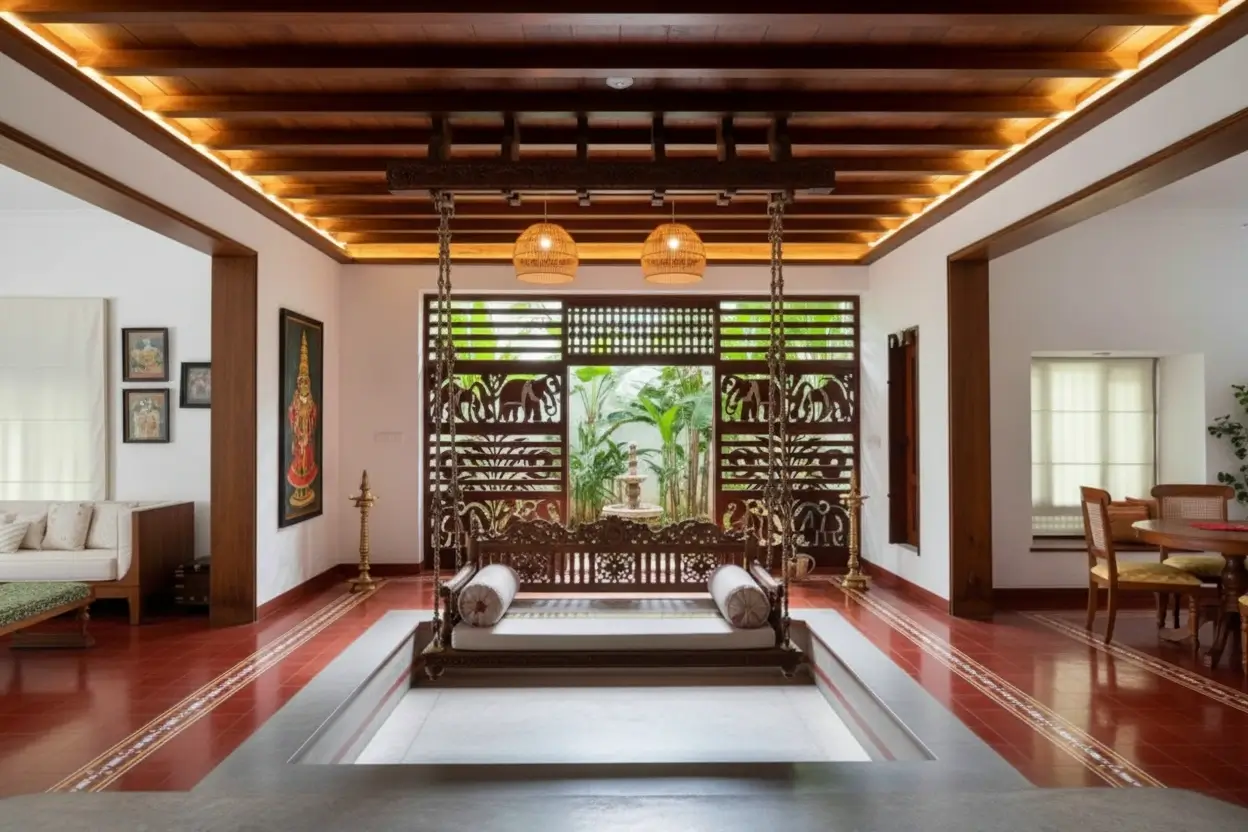- November 3, 2025
Kerala Traditional Elements + Modern Interiors: How to Blend Both
Kerala homes have always carried a unique identity — calm, earthy, rooted and elegant. At the same time, many homeowners today prefer modern interiors that feel minimalist, functional and clean. Blending both worlds is not only possible, but it produces a home that feels warm, stylish and culturally connected.
What makes Kerala traditional interiors special?
The DNA of a Kerala home is in the natural materials. Woodwork, carved details, earthy tones, terracotta tiles, sloped roof influence, open verandahs and calm lighting — all these elements create emotional connection and familiarity. There is also influence from temple architecture, local crafts and a lifestyle that respects climate.
How to blend tradition with modern interiors
1) Use wood as an accent
Teak, rosewood, jackwood visuals have always been part of Kerala. You don’t need full wooden rooms. Instead:
- wooden rafters as a ceiling highlight
- wooden frames for niches and openings
- a carved wooden console table near foyer
Pair this with clean modern furniture, matte finishes or neutral toned sofas. Balance is the goal.
2) Choose earthy colours
Traditional Kerala colours are not bright or loud. They are natural:
- clay red
- mustard
- olive green
- deep brown
- ivory
Use these tones as wall accents, curtains, rugs or cushions. Combine them with modern whites, greys and beiges. The mix immediately brings depth into the space.
3) Add brass and traditional décor elements
Brass is an iconic Kerala material. But in modern interiors, use it subtly:
- brass handles for cabinets
- uruli on a centre table
- brass diya near pooja corner
- brass knobs in wardrobes
Do not overdo. One or two pieces can act as visual anchors.
4) Local crafts + modern geometry
Traditional mural art, wooden lattice patterns (jali), banana fibre weaves, cane work — these can blend well with modern interior geometry.
Examples:
- a modern TV unit with a small jali strip detail
- a neutral colour sofa with a mural art frame behind
- cane lampshades in a contemporary dining space
This maintains the modern layout yet brings Kerala soul.
5) Mix flooring material wisely
Instead of full old-style red oxide or fully glossy vitrified tiles, try combinations:
- vitrified tiles + wooden vinyl planks
- natural stone borders
- textured tiles with earthy pattern
This is climate-friendly too. Kerala weather is humid — so choose finishes that can handle moisture.
6) Add greenery as a visual softener
Traditional Kerala homes always had indoor plants, tulasi thara, courtyard plants. Modern homes can use:
- indoor palms
- money plants
- pothos trailing shelves
- terracotta planters
It creates freshness and connects interior to nature — which is a strong Kerala signature.
What this fusion achieves
* the home stays modern, minimal and clutter-free
* but still feels familiar, warm and culturally rooted
* interior does not feel “copied from Pinterest” — it feels personal to Kerala lifestyle
This style is becoming popular in cities like Trivandrum, Kochi and Calicut because it respects heritage while offering comfort of current lifestyle.
Conclusion
A good interior designer can identify where tradition must lead and where modern design must take over. The line is delicate. The aim is not “theme based” interior. The aim is “identity based” interior.
If you are planning a renovation or designing a new house in Kerala and want this perfect balance, reach out. Blending tradition with modern minimalism is an art — and when done right, the home will never go out of style.
Gazella Interiors specialises in creating interiors that respect Kerala’s cultural depth while delivering modern lifestyle comfort. Our team studies your space, your routine, your preferences and then develops designs that feel personal and timeless — not generic. Whether it’s a city apartment or a traditional family home, we help you achieve a beautiful fusion of heritage and contemporary living.



